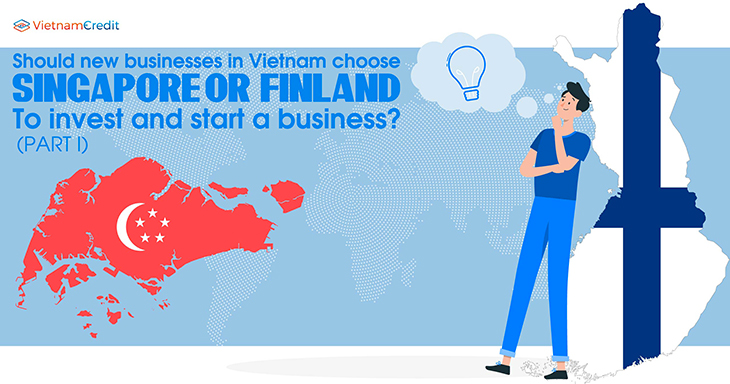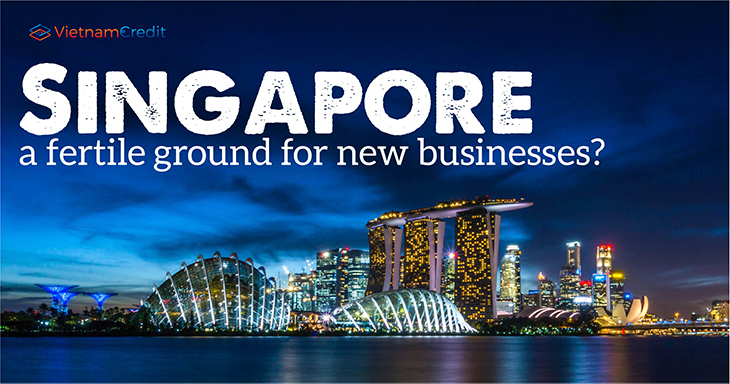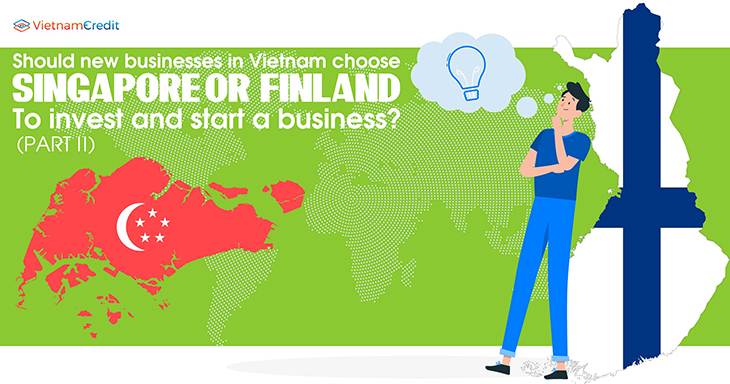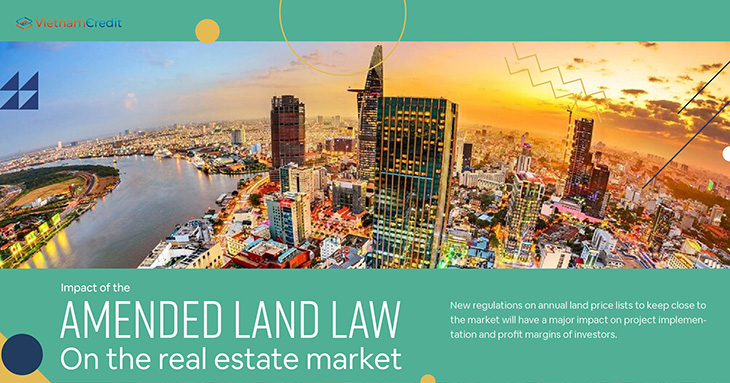Although Singapore and Finland are both developed and innovation-driven economies - the most advanced stage of an economy, there are significant differences in an entrepreneurial capacity, shown in 6 key differences.
I.Country background
➢ Singapore
Singapore is a high-income country which is located in South East Asia with a total area of 692km2 and a population of approximately of 5.535 million in 2019. Regarding the political stance, the country is a multi-party parliamentary republic ruled by the People’s Action Party (PAP). With the guidance of the party after the country’s independence from the British colony, Singapore has experienced remarkable socioeconomic development due to the party’s astute policymaking. Singapore has a highly developed and successful free-market economy with the ranked at 2 over 178 countries researched. Particularly, it has a remarkably corruption-free environment, stable prices, and a per capita GDP higher than that of most developed countries. In the period of 25 years from 2000 to 2019, the country witnessed a rapid growth in GDP, from under $50 billion to around 3$00 billion USD in 2019.
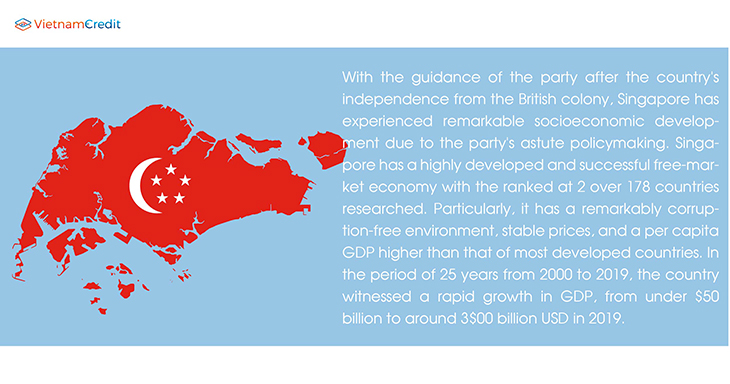
With stability and consistency in the ruling, the PAP has been continuously improving social stability, employment opportunities, and improvement in living standards. Due to the country’s favorable socioeconomic conditions, the country attracted a great number of immigrants and became a cosmopolitan nation with the proportion of ethnic groups: Chinese 74.2%, Malay 13.3%, Indian 9.2%, other 3.3% (2019 estimation)
Singapore’s legal system is based on English common law; according to Rule of Law Index 2015, the country ranks at 9/102 economies, remarkably with the country’s regulatory environment as extremely business-friendly. Specifically, in the Ease of Doing Business Index 2016 by the World Bank, the country is ranked in the first position in the world.
➢ Finland
Democratic republic Finland with 5.48 million people, 338,145 sq. km, is located in northern Europe, between Russia and Sweden. The country is famous for its leading education attainment in the world. In terms of global competitiveness and ease of doing business, Finland ranks 8th and 9th respectively.
Finland’s Government focuses on recovering the economy through cutting public debt and fostering the ease of doing business. However, individual and business taxes remain high comparing to OECD. A political potential challenge for this country is the stance on the Euro crisis.
Though after the economic crisis, Finland’s economic recovery is fragile, the country has still taken high rank in terms of economic freedom. Additionally, its conducive business environment allows the cost of starting a business in Finland (1.1% of GDP per capita) much lower than in other European countries (3.4% of GDP per capita). The challenge is a high budget deficit which leads to cut expenditure on R&D and entrepreneurship programs. Credit conditions or access to bank finances for SMEs, though remain limited, have been eased.
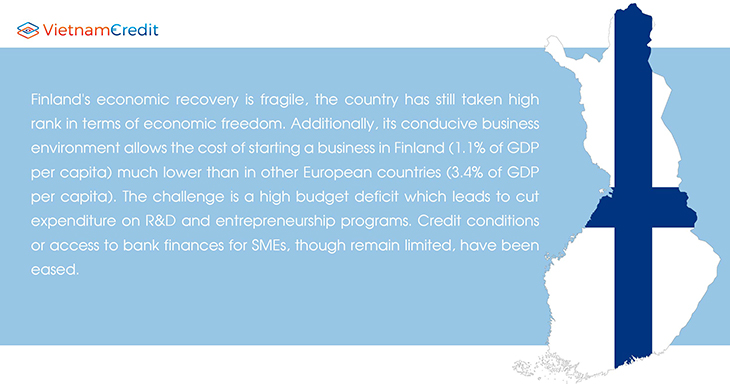
Finland is facing serious problems of the aging population as increasing in out of working age rate is estimated to reach 25% by 2060. A large number of SMEs are lacking a skilled workforce, and looking to recruit foreign labor. Labor costs are also increasing sharply in Finland, about 2.5% per annum, compared to other European countries.
In terms of the technological landscape, although Finland cut R&D expenditure to only 0.07% of GDP, it still remains the innovation leader position in the world. However, this cut is said to leave long-term harms such as discouragement of R&D investment of small firms.
II. Six key differences
1. Intention to start a business in the next 3 years
Entrepreneurial intentions rate is the percentage of individuals between 18 - 64 years old wishing to start-up within three years. Singapore GEM report explains that entrepreneurship typically starts with an intention to venture into the business world. Therefore, Singaporean’s higher entrepreneurial intention sets the first step for its higher entrepreneurial capacity than Finnish’s.
There is a positive correlation between perceptions and intentions. In detail, the perceived opportunities rate measures the percentage of individuals seeing the occasion to start a venture in the next six months. Perceived capabilities rate is the percentage of individuals believing that they acquired adequate skills, knowledge to start a new business. As long as people perceive that they have good capacity and see opportunities, they tend to be confident, then impulse the wish to start up. The surveys in both Singapore and Finland GEM Report through years demonstrate this correlation since as perceptions in entrepreneurship increase, people’s desire to establish their own business also increases.
However, the high rate of perception does not necessarily imply a high rate of entrepreneurial intention. Perceived behavioral control which can be perceived as skills or perceived opportunities has less influence on entrepreneurial intention of the innovation economy where the education level is high, and social value toward entrepreneurship is low. Start-up intention in these countries is complex and influenced by other factors such as social values, education, etc rather than purely people’s perceptions.
This explains why the analysis from Singapore and Finland is not a contradictory result:
Intention to start in Finland is low, compared to other countries while its perceived opportunities and capabilities are high. The intention in Singapore is high while perceived opportunities and capabilities are low.
➢ Entrepreneurial education
People who experience entrepreneurial education are able to perceive their capacities and opportunities better. This demonstrates that the main driver of start-up intention is entrepreneurship education. Though general education in Singapore and Finland relatively rank 1st, and 2nd place in the Global Competitiveness Index (2018), their entrepreneurial educations are different.
Singapore is said to have the best entrepreneurial education in the world, considered as an “Entrepreneurial hub”. Its entrepreneurship education and training in EFC scored higher than Finland and the average of other selected countries’ Singapore GEM report (2019). Local experts also state that its institutions and universities are able to provide effective, and adequate training in terms of entrepreneurship.
In contrast, the Finland GEM report 2019 mentions that despite much entrepreneurial support available, Finnish does not exploit effectively. Finnish universities also do not adequately utilize untapped entrepreneurial resources and opportunities, thus lack a model to develop the entrepreneurial capacity for their students.
➢ Socio-culture
Socio-culture has a significant impact on drawing perspective and behavior of individuals, hence individual decision to become entrepreneurs could depend on their positive or negative values on entrepreneurship. Alexandros et. al, (2014) further support this argument by showing that social norms and personal values account for 61% of entrepreneurial intention variance. Specifically, risk-taking is one of the most prominent traits closely linking to entrepreneurial tendency. The higher level of uncertainty avoidance is, the less will the society prefer entrepreneurship.
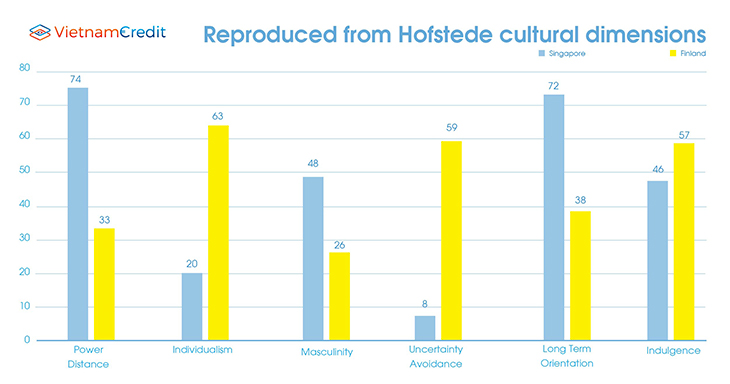
Singaporean society scores low in uncertainty avoidance while Finnish society shows a high degree of uncertainty avoidance. This implies that unlike Singaporeans who are willing to tolerate risks, Finnish tend to be more threatened by entrepreneurial risks. This culture is likely to discourage entrepreneurial intention
Besides that, the country attains top 10 positions in terms of an entrepreneurial supportive culture. Its government in 2019 encourages entrepreneurial activities by developing risk-taking culture among locals and small and medium enterprises.
On the contrary, Finnish experts conclude that social support for entrepreneurship in their country is just fairly. A change in entrepreneurial attitude among Finnish is needed to encourage entrepreneurship.
Clearly, Singapore is more attractive than Finland in terms of entrepreneurial education and socio-cultural support.
2. Total early entrepreneurial activities rate
Together with the intention to create new businesses, early entrepreneurial activities is the second stage which is a key indicator measuring entrepreneurship capacity in a country.
The TEA rate is defined as the percent of the adult population among 18 - 64 years old that is either actively involved in starting a new venture or a business less than 42 months old. Since there is a large proportion of businesses not surviving for long, the greater the TEA rate is, the more steady entrepreneurship capacity is.
Singapore’s TEA rate take 6th position, comparatively high in the context of innovation-driven economies. Finland ranks only 22nd out of 29, indicating a low level of adult engagement in early-stage entrepreneurial activities. However, both economies have relatively stable TEA rates, around 11% in Singapore and 5.5% in Finland.
➢ Economic development
There is a U-shaped relationship between a country's TEA rate and its level of economic development, or GDP per capita in particular.
With the average GDP per capita of $ 40 million during 4 recent years and 6% in the TEA rate, Finland is nearly in the bottom where is the end of the downward curve in business start-up. This can be explained that as its economy develops to a given point, the increase of real wage, from 0.3% in 2016 to 1.4% in 2018 implies an increase in the opportunity cost of self-employment. As a result, Finnish prefer to be employees, receiving stably rising wage rather than to take entrepreneurial risks.
On the other hand, Singapore has a higher GDP per capita, around $60 million. Its economy reaches the point that the TEA rate is revival. increasing consumer demand resulted from an increase in people’s wealth, brings about the creation of new market niches. This is a favorable environment for small businesses that aim to serve small, special markets. Furthermore, Maslow, 1970 (cited in Wenneker, 2004) self-realization is on the top of human motivation. Thus after satisfying physical needs, Singaporean would probably demand immaterial needs such as autonomy, self-realization in their career. Early entrepreneurial activities in the innovation-driven economy differ from those in factor and efficiency-driven economies in the way that they consist of many different kinds, exploiting knowledge, and motivated by opportunities-based.
➢ Gross national saving & Government budget balance
Numbers about gross national saving and government budget deficit reveal a positive macroeconomic situation in Finland while raising concerns about Finland’s situation.

National savings equals gross domestic investment plus the current account balance. Therefore, Singapore’s high level of national saving has important implications for business development since it provides a source of funds available for domestic investment. Specifically, the Singapore government supports entrepreneurship through funding systems, and prioritize entrepreneurship development on the top of its agenda.
In contrast, Finland faces a serious budget deficit. General government budget balance as general government revenue minus total expenditure. As a result, the Finish government is trying to cut its expenditure, especially on R&D and entrepreneurship programs.
Overall, macroeconomic factors leave a negative influence on early entrepreneurial activities in Finland. Unlike Finland, TEA in Singapore is likely to receive much more support from these factors. However, Finland’s position in the U-curve reveals “blank space” for TEA to further develop. As global entrepreneurs, we can take advantage of the current poor competitiveness of entrepreneurial activities.
3. Rate of nascent entrepreneurs
The TEA stage is composed of two phases: nascent entrepreneurship and new firm entrepreneurship. With the link to the first stage of the entrepreneurship process - the intention to start a business whether the transition from that stage to nascent entrepreneurship takes place soon is significantly important to the contribution of the total TEA rate. In order to facilitate such a transition and shape a country’s entrepreneurship environment, the country should have a well supported entrepreneurial eco-system. In the GEM global research, that eco-system is evaluated by using entrepreneurial framework conditions (EFC) which are essential for new businesses to grow and develop at their initial stage. EFC is assessed using the data collected from national experts in the public and private sectors.
Acknowledging that, there is a worth noticing difference in the rate of nascent entrepreneurship between Singapore and Finland. The rate of Singapore is by far greater than that of Finland, respectively at 6.4% and 3.5% of people aged 18-64 of the total population which accordingly ranks Singapore and Finland at 4th and 20th positions out of 27 innovation-driven economies.
The underlying reasons for such a great difference is analyzed using two of nine EFC which are government policy and government entrepreneurship programs. For these two conditions, Singapore was a top performer out of 27 innovation-driven countries.
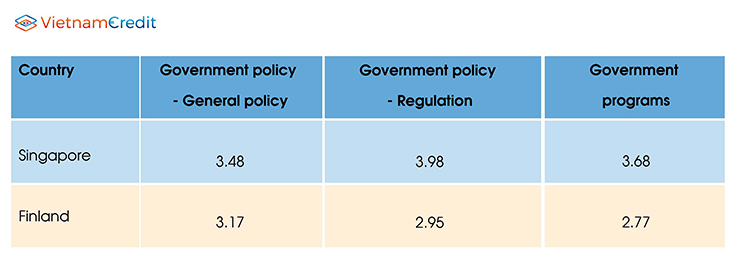
When directly comparing Singapore and Finland, as seen in the table above adapted from the GEM Global report 2019, indicators show that Singapore received a better response from the national experts on both conditions.
➢ Government policies
In general, national experts in Singapore felt that government places a high priority on the new businesses to grow. Several aspects of government policy such as granting of permits and licenses, taxes, and regulations were also rated highly by local experts. The Singapore government to be one of the most efficient governments in the world which was especially actively involved in the improvement of policymaking in the business front. The efficiency can be illustrated by the fact that Singapore has become a top destination in the Ease of Doing Business and was ranked in the 2nd position for economic freedom across the world. Exclusively, on average it only takes 3 procedures and 2.5 days to start a business in Singapore. From those figures, Singapore can be considered to be extremely business-friendly which would support the establishment and development of nascent entrepreneurs.
Other incentives worth taking into account are the country’s lowest corporate tax and strong property protection. Currently, the country has established double tax agreements with 67 countries to help foreign enterprises to avoid being taxed twice. Consequently, this would not only encourage domestic entrepreneurs but also foreign startups to set up business in Singapore and again raise the nascent entrepreneurship rate.
In the EU region, the Finnish government is also considered to be efficient and astute in economic policymaking. The country also ranked high in the Ease of Doing Business 2019, in the 10th position. However, when compared to Singapore’s performance, on average it takes 14 days to complete the starting business process which is more than 10 days longer. It takes even longer in the registering property and construction permit with 32 and 64 days respectively while the figure of Singapore was by far lower (4.5 and 26 days). Besides, in other economic and regulatory indicators, Finland is overtaken by Singapore.
Another disadvantage that new businesses would be discouraged to operate in Finland compared to Singapore is that the level of corporate tax in the country is still high although it was reduced to 20% in 2019. A high rate of tax would increase the operating costs and reduce the profitability of new businesses at the early stage of development.
From the difference in the procedural process of setting up the business in both countries and business administration, it is understandable that new startups in Finland should be putting more effort in terms of time and financial investment to start a business than in Singapore.
As a result, Singapore is placed in a better position to motivate SMEs establishment so that increasing the nascent entrepreneurship rate.
➢ Government entrepreneurship programs
The EFC also evaluates the extent of government support for new and growing firms in terms of the quantity and efficiency of government programs.
● Singapore
Local experts acknowledged that the government provided new firms with adequate and efficient support with accessibility. Specifically, the government took special attention to help SMEs running their operations by launching tax deduction schemes such as Productivity and Innovation Credit. The scheme entails 400% tax deductions/allowances on up to $296,800 expenditure per year in the training of employees, acquisition & registration of intellectual property, registration of, and R&D. In addition the government also introduced a new SME working capital loan scheme for loans up to $222,600 per SME which would definitely boost SME’s innovation, productivity, and especially competition.
The government also places special attention on the country’s technological landscape by actively promoting R&D such as providing companies, especially cash-constrained firms, with tax incentives and cash conversion schemes.
● Finland
In Finland national experts did not appreciate government support highly. Especially in the R&D sector government’s incentive to foster such activities are poor in the region and many other OECD countries. The country has fared poorly in both direct public funding of business R&D and the rate of tax subsidies given by the government as a percentage of GDP accounted for just 0.07%. Worse, the government didn't provide any indirect support through R&D tax incentives as of 2019.
(End of part I)
An Nguyen - Vietnam Credit

